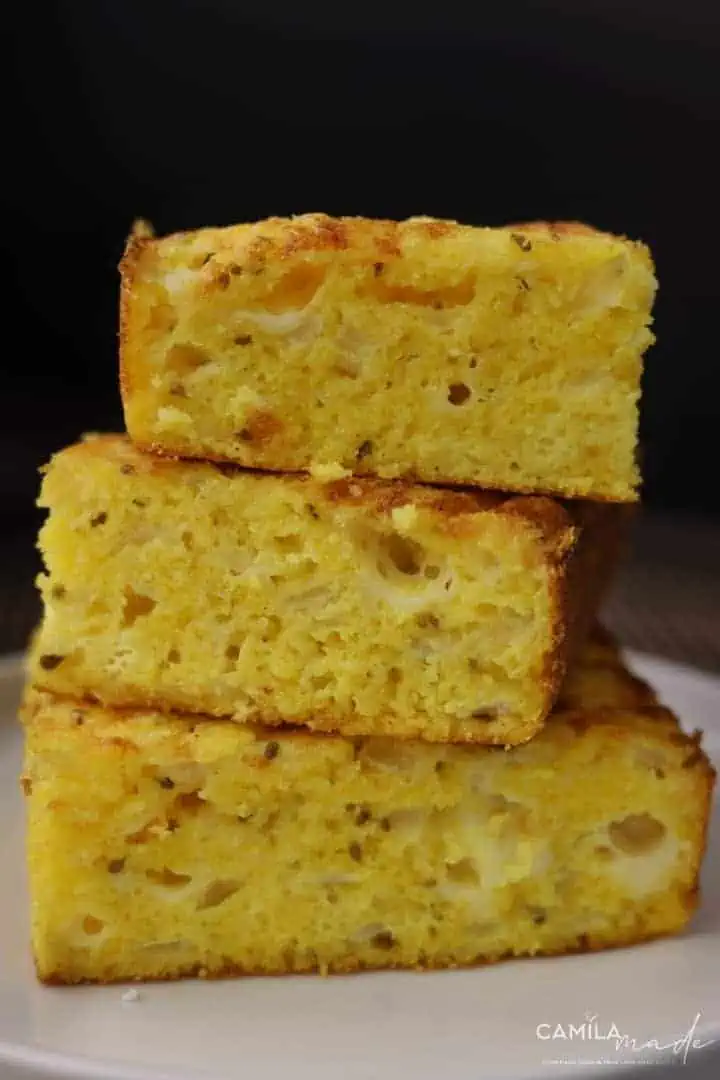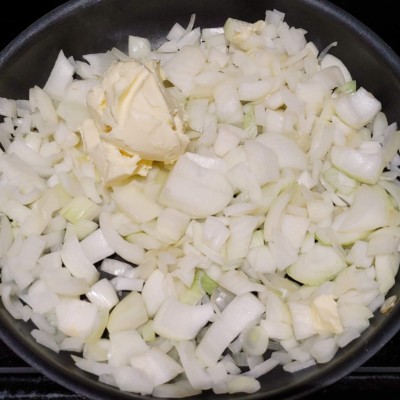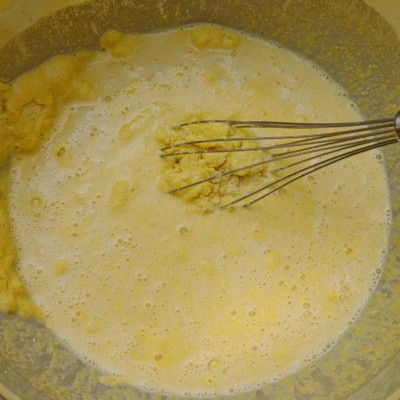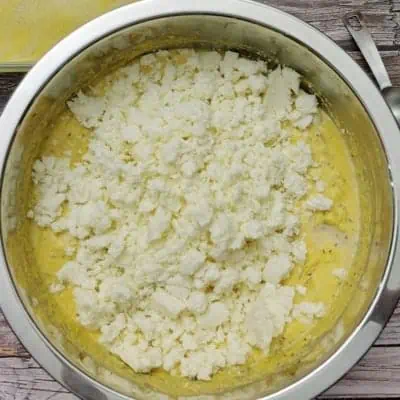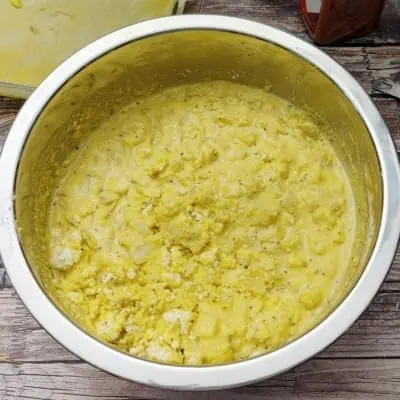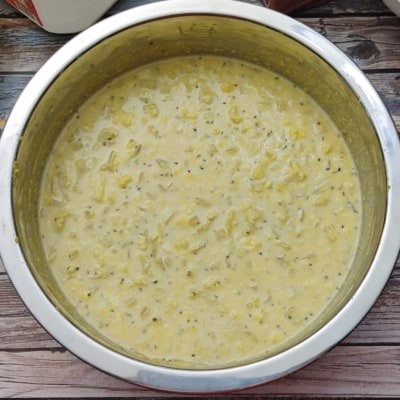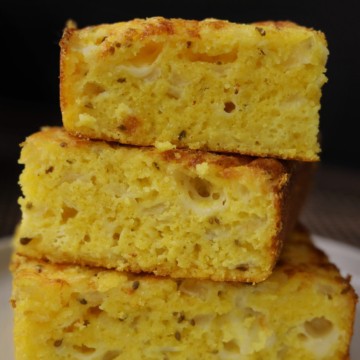Today, I'm sharing my special recipe for Sopa Paraguaya, a beloved Paraguayan cheesy cornbread.
Traditionally made with basic ingredients such as corn flour, lard, cheese, milk, and eggs, this classic dish is known for its dense texture.
My version, however, stands out for its texture and flavor. I achieve this by incorporating buttermilk, butter, and a generous amount of onion, along with baking powder and a subtle hint of anise seeds for additional flavor.
This combination transforms the typically dense and dry cornbread into a moist, tender, light, and absolutely delicious masterpiece!😋
In a nutshell, the inspiration for this recipe comes from my family, especially my husband. He told me that back in Paraguay, the Sopa Paraguaya he had was often too dry and dense, leading him to prefer Chipa Guazu, a similar dish made with fresh corn instead of corn flour. I felt the same about the traditional Sopa Paraguaya – it wasn’t quite right for me either. 🙁
Motivated by this, I set out to perfect the Sopa Paraguaya and other Paraguayan recipes. After lots of trials and errors (all of which my family happily devoured! 🤭),
I've finally archived what I believe to be the perfect version. My Paraguayan Sopa recipe has become a beloved favorite in our household! 🙂 It's not just my husband who adores it, but also my children and everyone else who's tasted it. 😊👨👩👧👦🎉
I'm confident that you'll love it as much as we do – it's so good that you'll want to keep eating even when you're full! So, if you're interested in more Paraguayan-inspired recipes, be sure to check out our Chipa Guazu, Sopa So'o, Microwave Sopa, Chipa Guazu Muffins, and Authentic Chipa Guazu.
How to Make Sopa Paraguaya
Note: The full instructions are provided in the recipe card below.
Preheat Oven: Preheat the oven to 350°F (175°C) and position the oven rack in the middle.
Prepare Baking Dish: Grease a 13'' x 9'' baking dish with butter, ensuring all sides and corners are well coated. Sprinkle cornmeal evenly over the greased baking dish, covering the bottom and sides. Gently shake off any excess cornmeal from the dish. Set the prepared baking dish aside.
Cook Onions: In a large skillet over medium-high heat, melt the butter. Add the chopped onions and salt to the skillet and cook them until they become soft and transparent; do not let them brown for about 5 to 10 minutes. Remove the skillet from heat, and stir in half of the buttermilk. Set aside to cool to room temperature.
Prepare Batter: In a large mixing bowl, beat the eggs until frothy. Add the cooled onion mixture, cornmeal, anise seeds (rubbed to release flavor), and the remaining buttermilk. Whisk everything together until thoroughly combined, then gently stir in the cheese.
📌(Resist the urge to add extra cornmeal. The batter will have a runny consistency, but this is intentional to keep the Sopa Paraguaya light and prevent it from becoming too dense).
Bake: Transfer the cornmeal mixture to the prepared baking dish and tap it gently to even it out. Bake it in the oven until it turns golden brown and the center is set, about 50 to 60 minutes, or until a cake tester or toothpick inserted in the center comes out clean.
Serve: Allow the Sopa Paraguaya to cool in the pan for 10 to 15 minutes, then cut it into squares and serve it warm.
✏️Pro Tip: Before adding the anise seeds to the batter, rub them between your palms to release their flavor and aroma. This will enhance the taste of the anise seeds and infuse the Sopa Paraguaya with their delightful essence.
See More Paraguayan Recipes:
- Authentic Chipa Guazu
- Healthy Corn Souffle is a Low Fat Version of Chipa Guazú
- Corn Souffle Muffins
- Spoonbread
- Savory Cornbread with Cheese and anise seeds
- Sopa So’o “Beef Cornbread Casserole”
Recipe
Easy Sopa Paraguaya
Tools
Ingredients
- 3 medium onions , chopped
- 113 gr (about ½ cup) butter
- 500 gr. Queso Panela or Queso Blanco , crumble into small pieces.
- 2 cups buttermilk or whole milk , room temperature
- 5 large eggs , room temperature
- 1-½ teaspoons kosher salt
- 1 tablespoon baking powder , optional but highly recommended
- 400 g Quaker yellow cornmeal
- 1 tablespoon anise seeds , optional but highly recommended
Instructions
- Preheat Oven: Preheat the oven to 350°F (175°C) and position the oven rack in the middle.
- Prepare Baking Dish: Grease a 13'' x 9'' baking dish with butter, ensuring all sides and corners are well coated. Sprinkle cornmeal evenly over the greased baking dish, covering the bottom and sides. Gently shake off any excess cornmeal from the dish. Set the prepared baking dish aside.
- Cook Onions: In a large skillet over medium-high heat, melt the butter. Add the chopped onions and salt to the skillet and cook them until they become soft and transparent; do not let them brown for about 5 to 10 minutes. Remove the skillet from heat, and stir in half of the buttermilk. Set aside to cool to room temperature.
- Prepare Batter: In a large mixing bowl, beat the eggs until frothy. Add the cooled onion mixture, cornmeal, anise seeds (rubbed to release flavor), and the remaining buttermilk. Whisk everything together until thoroughly combined, then gently stir in the cheese.
- 📌(Resist the urge to add extra cornmeal. The batter will have a runny consistency, but this is intentional to keep the Sopa Paraguaya light and prevent it from becoming too dense).
- Bake: Transfer the cornmeal mixture to the prepared baking dish and tap it gently to even it out. Bake it in the oven until it turns golden brown and the center is set, about 50 to 60 minutes, or until a cake tester or toothpick inserted in the center comes out clean.
- Serve: Allow the Sopa Paraguaya to cool in the pan for 10 to 15 minutes, then cut it into squares and serve it warm.
Notes
All nutritional information is based on third-party calculations and is only an estimate. Each recipe and nutritional value will vary depending on the brands you use, measuring methods, and portion sizes per household.

